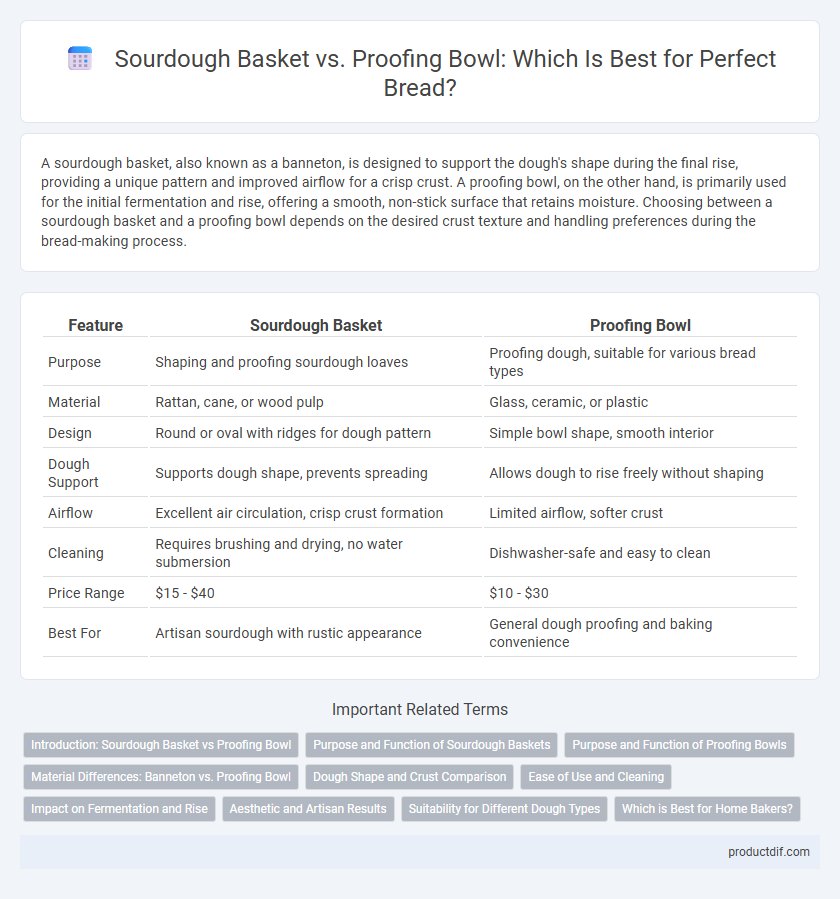A sourdough basket, also known as a banneton, is designed to support the dough's shape during the final rise, providing a unique pattern and improved airflow for a crisp crust. A proofing bowl, on the other hand, is primarily used for the initial fermentation and rise, offering a smooth, non-stick surface that retains moisture. Choosing between a sourdough basket and a proofing bowl depends on the desired crust texture and handling preferences during the bread-making process.
Table of Comparison
| Feature | Sourdough Basket | Proofing Bowl |
|---|---|---|
| Purpose | Shaping and proofing sourdough loaves | Proofing dough, suitable for various bread types |
| Material | Rattan, cane, or wood pulp | Glass, ceramic, or plastic |
| Design | Round or oval with ridges for dough pattern | Simple bowl shape, smooth interior |
| Dough Support | Supports dough shape, prevents spreading | Allows dough to rise freely without shaping |
| Airflow | Excellent air circulation, crisp crust formation | Limited airflow, softer crust |
| Cleaning | Requires brushing and drying, no water submersion | Dishwasher-safe and easy to clean |
| Price Range | $15 - $40 | $10 - $30 |
| Best For | Artisan sourdough with rustic appearance | General dough proofing and baking convenience |
Introduction: Sourdough Basket vs Proofing Bowl
Sourdough baskets, also known as bannetons, are designed to support the dough's shape during the final rise, creating a structured form and distinctive pattern on the crust. Proofing bowls offer a smooth surface for dough fermentation without imprinting marks, ideal for softer doughs or when a uniform crust is desired. Choosing between a sourdough basket and proofing bowl depends on the desired bread texture, crust aesthetics, and dough hydration levels.
Purpose and Function of Sourdough Baskets
Sourdough baskets, also known as bannetons, are designed to support the dough during its final rise, maintaining shape and structure for an even, airy crumb in artisanal bread. Unlike proofing bowls, which primarily contain the dough, sourdough baskets provide airflow through their cane or rattan construction, helping to create a natural crust pattern and improve fermentation. The ridges inside sourdough baskets also leave distinctive imprints on the dough, enhancing the loaf's aesthetic appeal.
Purpose and Function of Proofing Bowls
Proofing bowls provide a controlled environment for dough to rise, maintaining moisture and supporting consistent fermentation. Unlike sourdough baskets, which are primarily used to shape and imprint the dough before baking, proofing bowls facilitate the initial proofing stage, allowing yeast activity to develop robust gluten structure. Their smooth interior prevents sticking and promotes uniform expansion, essential for optimal dough texture and rise.
Material Differences: Banneton vs. Proofing Bowl
Sourdough baskets, or bannetons, are typically made from natural materials such as cane, rattan, or wicker, which promote airflow and help create a crisp crust by allowing the dough to breathe during proofing. Proofing bowls are often crafted from ceramic, glass, or plastic, providing better moisture retention that keeps the dough soft and prevents drying out. The choice between a banneton and a proofing bowl depends on the desired crust texture and dough hydration level during the fermentation process.
Dough Shape and Crust Comparison
Sourdough baskets, commonly called bannetons, promote a round, well-defined dough shape with characteristic spiral or lined patterns that enhance the bread's aesthetic appeal and structural integrity. Proofing bowls, typically smooth and untextured, allow for more varied shapes but often result in a less firm crust due to reduced surface tension during fermentation. The natural cane or rattan material of sourdough baskets absorbs excess moisture, fostering a crispy, rustic crust, while proofing bowls tend to retain humidity, yielding a softer crust texture.
Ease of Use and Cleaning
Sourdough baskets offer structured support for dough shaping but often require flouring to prevent sticking, making cleaning slightly more involved due to their natural rattan material. Proofing bowls, typically made from plastic or ceramic, provide smooth surfaces that are easier to clean and require less preparation before use. Both tools enhance dough fermentation, but proofing bowls excel in ease of use and maintenance for everyday baking.
Impact on Fermentation and Rise
Sourdough baskets, also known as bannetons, provide structured support during fermentation, promoting even airflow and maintaining the dough's shape for a consistent rise and crust formation. Proofing bowls typically offer a smoother surface, resulting in a slightly different dough texture and potentially less pronounced scoring patterns. The choice between these tools significantly influences the dough's expansion and crumb development throughout the fermentation and proofing stages.
Aesthetic and Artisan Results
A sourdough basket, or banneton, imparts distinctive spiral or woven patterns onto the dough, enhancing the bread's artisan appearance with natural, rustic aesthetic appeal. Proofing bowls, typically smooth and made from glass or ceramic, yield a sleeker, more uniform crust and shape, ideal for minimalist presentation. Choosing between the two influences the final bread's visual texture and craftsmanship, aligning with desired artisan style and aesthetic preferences.
Suitability for Different Dough Types
Sourdough baskets, typically made from natural rattan, are ideal for high-hydration doughs, promoting airflow to create a crisp crust and distinctive spiral patterns. Proofing bowls, often made from ceramic or plastic, suit a wider range of dough types, including wetter and denser varieties, by providing a non-stick surface and consistent shape during fermentation. Choosing between the two depends on the dough's hydration level and desired crust texture, with sourdough baskets favored for artisan-style loaves and proofing bowls for versatility in everyday baking.
Which is Best for Home Bakers?
Sourdough baskets, or bannetons, offer excellent dough shaping and air circulation for crusty, artisan-style loaves, while proofing bowls provide versatile, all-in-one dough rising and handling suited for various bread types. Home bakers benefit from sourdough baskets when aiming for traditional, rustic bread with defined patterns, whereas proofing bowls are ideal for convenience and multiple bread forms. Choosing the best depends on whether the priority is aesthetic loaf structure or functional, multi-purpose dough proofing.
Sourdough basket vs Proofing bowl Infographic

 productdif.com
productdif.com